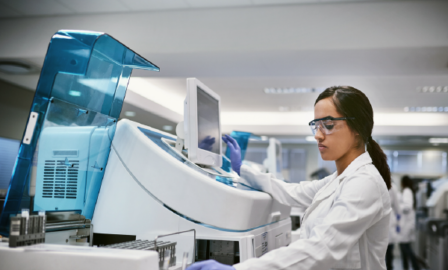FDA Clearance of Apple Watch 4 Shows Key Trend in Medical Device
Last week, Apple unveiled that it had received FDA clearance for the Apple Watch Series 4, further solidifying one of the top medical device trends of 2018. Over the past years, Apple had been investing time and resources into exploring digital health capabilities for its technology. The public announcement that the tech giant had received clearance from the FDA signifies a critical step towards its becoming a key player within the medical device space.
Until recently, the potential medical uses of the Apple Watch had to be taken with a grain of salt, as the data were prone to inconsistencies and measurements did not meet medical standards. However, the FDA clearance changes this narrative to a degree, as it paves the way for Apple to continue its ascension into healthcare.
Apple Watch’s Medical Upgrades are Legitimate
On stage at the feature reveal, Jeff Williams, Apple Chief Operating Officer, gave a breakdown of the Apple Watch’s new upgrades:
- Heart Rate Notification – the notification feature is an extension of the Apple Watch’s already established heart rate monitoring capability, except now users can choose to be alerted of abnormalities; for example, a notification will be sent if the device senses the heart is not pumping enough blood throughout the body.
- Heart Rhythm Screening – this feature allows the Apple Watch to screen for another metric, user’s heart rhythm, in the background of activity, and send a notification. Apple’s long-term goal is to help users identify heart rhythm issues or irregularities they may have never expected.
- ECG Measurement – this feature, the most disruptive of the upgrades, brings classic electrocardiogram (ECG or EKG) measurement, which is historically conducted by a doctor or clinician, to every everyday Apple Watch users. The FDA tagged the feature with a “de novo” clearance, meaning the device is novel, not based on any existing classification or predicate device on the market.
From a hardware perspective, Apple added electrodes into the device’s back sapphire crystal and digital crown. Now, when a user applies his or her fingertip to the digital crown, the built-in electrodes detect electrical impulses directly from the heartbeat and then transfers the signal to the device’s S4 chip for algorithms for analysis. After 30 seconds, the user receives a heart rhythm classification, with “Sinus” denoting a regular signal and “Atrial Fibrillation” denoting an irregular one.
The new ECG measurement feature is significantly more precise than the Apple Watch’s heart rate measurement, addressing the problem of tracker accuracy. Heart rate is calculated using green LED lights paired with light-sensitive photodiodes to detect the amount of blood flowing through a user’s wrist. The upgrade is clear – where the photodiode has to sense through layers of tissue and ambient noise, the ECG electrodes capture the signal directly with a higher rate of certainty.
How the New Features will Impact Healthcare
Ivor Benjamin, President of the American Heart Association and a leading cardiologist, followed Williams on stage and elaborated on the ECG upgrade’s capacity to affect the way patient data is captured and disseminated.
“Capturing meaningful data about a person’s heart in real-time is changing the way we practice medicine,” stated Benjamin. “In my experience, people often report symptoms that are absent during medical visits. That is why information is vital. Information about a person’s daily lifestyle choices and their specific health data. The ability to access health data on an on-demand electrocardiogram is game changing.”
To date, Apple Watch adoption has been climbing 56% year-over-year, as many users derive value from its seamless health tracking capability. For example, its functionality in monitoring user’s daily mobility, heart rate, and diet has been recognized, as much of a user’s health information can be stored and made transparent through Apple’s cloud-based Health App. The addition of the ECG projects to only increase this rate of data capture.
Data capture is at the forefront of the benefits of the Apple Watch. Not only does the FDA clearance legitimize the product for consumers in the short-term, it essentially greenlights Apple’s future forays into medical research. On November 30th, 2017, Apple announced its partnership with Stanford Medicine launching a research project aimed to identify irregular heart rhythms. The study gathered volunteers to wear the Apple Watch and feed their data back to doctors and researchers, allowing for improved transparency and insights into daily behavior. It is not a huge leap to surmise this pattern of research will continue for Apple.
Apple now owns the critical patient contact-point for gathering health data and boasts massive potential to make strides in the realms of consumer healthcare, diagnostics, and telemedicine within the next decade, or even the next five years. These developments parallel Amazon’s initiatives to disrupt healthcare delivery and treatment supply chain. From the perspective of the FDA, the tech giants are new players in the healthcare space, and they are here to stay.
The FDA, the crucial regulator that moderates the flow of medical innovation, has taken an open stance towards facilitating digital health. On the same day as the Apple Watch’s ECG was announced, FDA Director, Scott Gottlieb, and Radiological Health Director, Jeff Shuren, released a statement regarding the agency’s initiative to work with the tech industry to spur further innovation in digital health. This comes a year after the FDA voiced its support of personalized medicine initiatives, demonstrating the agency’s commitment to enforcing a high standard of what ideal, value treatment must entail in the modern age of medicine.
Download 6 Trends in Medical Device
Questions for Pharma and Biotech
The unveiling of the Apple Watch’s new feature is but a small step towards carving out a niche in healthcare, however, the event has major ramifications that will send ripples through pharma and biotech industries.
The rise of digital health begs many questions:
- How will increased health tracking educate patients?
- How will patients manage and control their private health data?
- Will more data augment the rate and success of clinical trials?
- Can clinical trials be performed on a remote and global level with the Apple Watch?
- Will drug-makers have to partner with Apple to access key information?
- Will improved tracking diagnostics shift treatments from reactionary to preventative?
- Will Phase IV post-approval drug monitoring be affected by more thorough patient tracking?
If you found this information interesting, subscribe to our blog below to receive the latest insights.
Subscribe to Clarkston's Insights
Contributions and co-author: Adam Kershner



